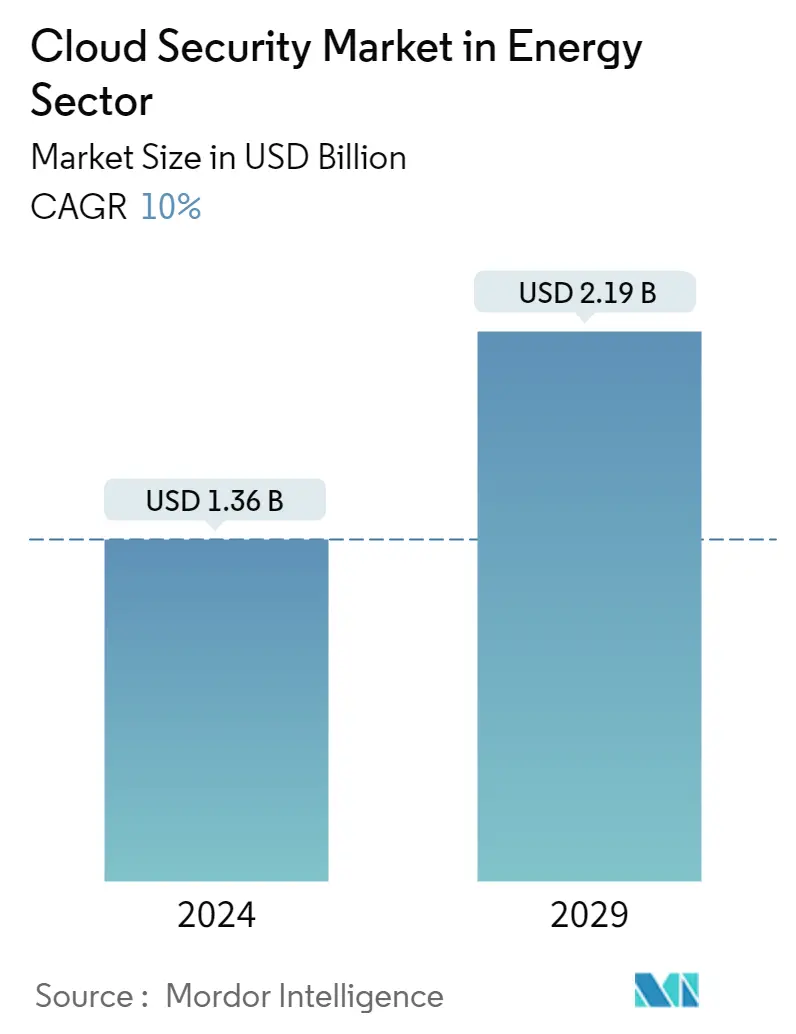Market Size of Cloud Security Industry in Energy Sector

| Study Period | 2019 - 2029 |
| Market Size (2024) | USD 1.36 Billion |
| Market Size (2029) | USD 2.19 Billion |
| CAGR (2024 - 2029) | 10.00 % |
| Fastest Growing Market | Europe |
| Largest Market | North America |
Major Players
*Disclaimer: Major Players sorted in no particular order |
Energy Sector Cloud Security Market Analysis
The Cloud Security Market in Energy is expected to grow from USD 1.36 billion in 2024 to USD 2.19 billion by 2029, at a CAGR of 10% during the forecast period (2024-2029).
Considering that nations want to reduce their carbon impact and switch to renewable energy sources, the energy sector is in the midst of a major transformation. The need to reduce greenhouse gas emissions, the falling cost of renewables, and the adoption of new technologies, such as smart grids, have increased the demand for storing, managing, and analyzing data. Energy firms have greatly benefited from using cloud technology to collect and utilize this data. Utility companies are collaborating with various cloud computing firms to provide security for this important data.
- According to Gartner, by 2024, cloud computing will account for more than 45% of IT spending on system infrastructure, infrastructure software, application software, and business process outsourcing. According to a recent Deloitte report, 83% of energy and utility companies either use cloud services or want to do so within the next two years. Many variables, such as greater agility and flexibility, lower capital expenditure (CapEx) costs, and enhanced operational efficiency, drive the use of clouds in the energy and utilities sector.
- Security becomes paramount when the systems are accessed outside the office premises. Legacy equipment is one of the main challenges of the energy sector. Operational Technology (OT) networks are becoming more connected because they are typically constructed using equipment over 15 years old. Security issues arise due to the fusion of the IT (Information Technology) and OT environments.
- The Covid-19 pandemic was the most important time for Cloud Storage as a revolutionary technology, further driving the demand for cloud security services. For power plants accessing the systems securely from remote locations became essential. Some companies switched to digital solutions like Zero Trust architecture, which provided security teams with greater contextual information by combining feeds from various places on a single dashboard in real time.
- April 2022 - Bharat Petroleum Corporation (BPCL) signed a contract with Microsoft that will give BPCL the intelligence to revamp its operations, create smarter supply chains, and boost customer engagement. Microsoft will provide network and security services to the organization in this seven year deal.
Energy Sector Cloud Security Industry Segmentation
Security techniques that are used in cloud computing to safeguard the data, programs, and infrastructure hosted in the cloud are called Cloud Security Techniques. These procedures ensure data and resource access management, data privacy protection, and user and device authentication. Also, they aid in the compliance of regulatory data. In cloud systems, cloud security safeguards data against distributed denial of service (DDoS) attacks, malware, hackers, and unauthorized user access or use. Greater agility and flexibility, lower capital expenditure (CapEx) costs, and enhanced operational efficiency drive the use of clouds in the energy and utilities sector.
The Cloud Security Market in Energy Sector is segmented by Solution Type (Identity and Access Management, Data Loss Prevention, IDS/IPS), Security Type (Application, Security, Database Security, Endpoint Security, Network Security, Web & Email Security), Service Model (IaaS, PaaS, SaaS), Deployment Type (Public Cloud, Private Cloud, Hybrid Cloud), and Geography. The market sizes and forecasts are provided in terms of value (USD).
| Solution Type | |
| Identity and Access Management | |
| Data Loss Prevention | |
| IDS/IPS | |
| Security Information and Event Management | |
| Encryption | |
| Other Solution Type |
| Security Type | |
| Application Security | |
| Database Security | |
| Endpoint Security | |
| Network Security | |
| Web & Email Security | |
| Other Security Type |
| Service Model | |
| Infrastructure-as-a-Service | |
| Platform-as-a-Service | |
| Software-as-a-Service |
| Deployment Type | |
| Public Cloud | |
| Private Cloud | |
| Hybrid Cloud |
| Geography | |
| North America | |
| Europe | |
| Asia Pacific | |
| Latin America | |
| Middle East and Africa |
Cloud Security Market in Energy Sector Size Summary
The cloud security market within the energy sector is poised for significant expansion, driven by the industry's shift towards renewable energy and the increasing reliance on digital technologies like smart grids. This transformation necessitates robust data management and security solutions, as energy companies collect and analyze vast amounts of data. The integration of cloud technology has become essential for these firms, enabling them to enhance operational efficiency and reduce capital expenditures. Collaborations between utility companies and cloud service providers are crucial in safeguarding sensitive data, especially as the convergence of IT and operational technology (OT) environments presents new security challenges. The COVID-19 pandemic further accelerated the adoption of cloud security solutions, highlighting the need for secure remote access to systems.
The energy sector's vulnerability to cyber threats, exacerbated by its complex supply chains and reliance on legacy systems, underscores the importance of advanced security measures. Cyberattacks can lead to significant financial losses and operational disruptions, making it imperative for companies to implement comprehensive cybersecurity strategies. Partnerships with cybersecurity firms and investments in technologies like Zero Trust architecture are becoming standard practices to protect against malicious attacks. The European Union's push for digitalization and the development of a common data space for energy further emphasize the need for robust cloud security solutions. As the market evolves, competition among major players like IBM, Cisco, and Microsoft intensifies, driving innovation and enhancing the security landscape for the energy sector.
Cloud Security Market in Energy Sector Market Size - Table of Contents
-
1. MARKET DYNAMICS
-
1.1 Market Overview
-
1.2 Introduction to Market Drivers and Restraints
-
1.3 Market Drivers
-
1.3.1 Increasing Adoption of IoT across the Supply Chain
-
1.3.2 Increasing Number of Cyber Threats
-
-
1.4 Market Restraints
-
1.4.1 Integration with Existing Architecture
-
-
1.5 Industry Value Chain Analysis
-
1.6 Industry Attractiveness - Porter's Five Force Analysis
-
1.6.1 Threat of New Entrants
-
1.6.2 Bargaining Power of Buyers/Consumers
-
1.6.3 Bargaining Power of Suppliers
-
1.6.4 Threat of Substitute Products
-
1.6.5 Intensity of Competitive Rivalry
-
-
1.7 An Assessment of the Impact of COVID-19 on the Industry
-
-
2. MARKET SEGMENTATION
-
2.1 Solution Type
-
2.1.1 Identity and Access Management
-
2.1.2 Data Loss Prevention
-
2.1.3 IDS/IPS
-
2.1.4 Security Information and Event Management
-
2.1.5 Encryption
-
2.1.6 Other Solution Type
-
-
2.2 Security Type
-
2.2.1 Application Security
-
2.2.2 Database Security
-
2.2.3 Endpoint Security
-
2.2.4 Network Security
-
2.2.5 Web & Email Security
-
2.2.6 Other Security Type
-
-
2.3 Service Model
-
2.3.1 Infrastructure-as-a-Service
-
2.3.2 Platform-as-a-Service
-
2.3.3 Software-as-a-Service
-
-
2.4 Deployment Type
-
2.4.1 Public Cloud
-
2.4.2 Private Cloud
-
2.4.3 Hybrid Cloud
-
-
2.5 Geography
-
2.5.1 North America
-
2.5.2 Europe
-
2.5.3 Asia Pacific
-
2.5.4 Latin America
-
2.5.5 Middle East and Africa
-
-
Cloud Security Market in Energy Sector Market Size FAQs
How big is the Cloud Security Market in Energy?
The Cloud Security Market in Energy size is expected to reach USD 1.36 billion in 2024 and grow at a CAGR of 10% to reach USD 2.19 billion by 2029.
What is the current Cloud Security Market in Energy size?
In 2024, the Cloud Security Market in Energy size is expected to reach USD 1.36 billion.

